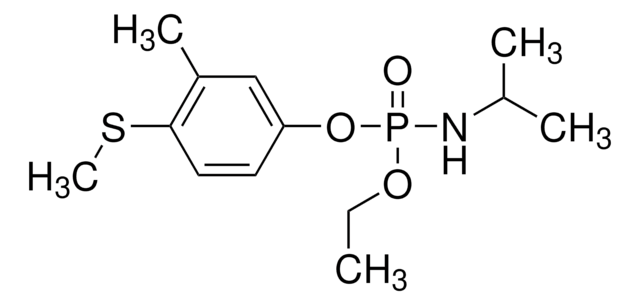51976
Ethyl alcohol, pure
≥99.8%, for molecular biology, (absolute alcohol, without additive, A15 o1), BioUltra
Synonym(s):
Ethyl alcohol
About This Item
Recommended Products
product name
Ethanol, BioUltra, for molecular biology, ≥99.8%, (absolute alcohol, without additive, A15 o1)
grade
for molecular biology
Quality Level
vapor density
1.59 (vs air)
vapor pressure
44.6 mmHg ( 20 °C)
product line
BioUltra
Assay
≥99.8%
form
liquid
autoignition temp.
683 °F
quality
(absolute alcohol, without additive, A15 o1)
expl. lim.
19 %, 60 °F
impurities
DNases, none detected
KMnO4-reducing substances, in accordance
RNases, none detected
insoluble matter, passes filter test
phosphatases, none detected
proteases, none detected
substances darkened by H2SO4, in accordance
≤0.0004% free alkali (as NH3)
≤0.001% aldehyde (as CH3CHO)
≤0.001% formaldehyde (as HCHO)
≤0.001% ketone (as CH3COCH3)
≤0.002% free acid (as CH3COOH)
≤0.1% methanol (CH3OH)
≤0.2% water
evapn. residue
≤0.001%
refractive index
n20/D 1.3600 (lit.)
n20/D 1.362
bp
78 °C (lit.)
mp
−114 °C (lit.)
solubility
H2O: miscible
organic solvents: miscible
density
0.789 g/mL at 25 °C (lit.)
cation traces
Al: ≤0.5 mg/kg
Ba: ≤0.1 mg/kg
Bi: ≤0.1 mg/kg
Ca: ≤0.5 mg/kg
Cd: ≤0.05 mg/kg
Co: ≤0.02 mg/kg
Cr: ≤0.02 mg/kg
Cu: ≤0.1 mg/kg
Fe: ≤0.1 mg/kg
K: ≤0.5 mg/kg
Li: ≤0.1 mg/kg
Mg: ≤0.1 mg/kg
Mn: ≤0.02 mg/kg
Mo: ≤0.1 mg/kg
Na: ≤1 mg/kg
Ni: ≤0.02 mg/kg
Pb: ≤0.1 mg/kg
Sr: ≤0.1 mg/kg
Zn: ≤0.1 mg/kg
SMILES string
CCO
λ
neat
UV absorption
λ: 260 nm Amax: 0.04
λ: 280 nm Amax: 0.03
suitability
suitable for molecular biology
application(s)
life science and biopharma
format
neat
InChI
1S/C2H6O/c1-2-3/h3H,2H2,1H3
InChI key
LFQSCWFLJHTTHZ-UHFFFAOYSA-N
Looking for similar products? Visit Product Comparison Guide
General description
Application
- in vehicle-treated controls to perform mouse experiments
- in viability assay along with crystal violet to stain human and mouse high-grade serous ovarian cancer (HGSOC) cells after stimulation
- to prepare 17β-estradiol (E2) to use in cell culture experiments
- in cell cycle analysis for fixing cells drop-wise
Biochem/physiol Actions
Features and Benefits
- Versatile and adaptable for a wide variety of laboratory and research applications
- BioUltra Grade for your Molecular Biology, Cell Biology and Biochemical research
- Tested to confirm low levels of heavy metal contamination, ensuring suitability for various applications
- Free from DNase, RNase, NICKase and proteaseTested for trace levels of Anions and Cations
Other Notes
Footnote
also commonly purchased with this product
comparable product
greener alternative product
Signal Word
Danger
Hazard Statements
Precautionary Statements
Hazard Classifications
Eye Irrit. 2 - Flam. Liq. 2
Storage Class Code
3 - Flammable liquids
WGK
WGK 1
Flash Point(F)
55.4 °F - closed cup
Flash Point(C)
13 °C - closed cup
Personal Protective Equipment
Regulatory Listings
Regulatory Listings are mainly provided for chemical products. Only limited information can be provided here for non-chemical products. No entry means none of the components are listed. It is the user’s obligation to ensure the safe and legal use of the product.
FSL
Group 4: Flammable liquids
Alcohols
Hazardous rank II
ISHL Indicated Name
Substances Subject to be Indicated Names
ISHL Notified Names
Substances Subject to be Notified Names
JAN Code
51976-500ML-F:
51976-BULK-F:
51976-VAR-F:
Choose from one of the most recent versions:
Already Own This Product?
Find documentation for the products that you have recently purchased in the Document Library.
Articles
Substances are said to be miscible in one another if they dissolve to form a uniform solution. Bookmark or download our miscibility table for common lab solvents.
Our team of scientists has experience in all areas of research including Life Science, Material Science, Chemical Synthesis, Chromatography, Analytical and many others.
Contact Technical Service








